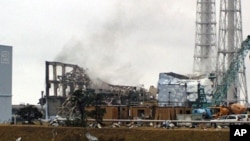U.S. nuclear officials said Tuesday that Japan's troubled Fukushima Daiichi nuclear power plant is slowly being brought under control after a deadly earthquake and tsunami led to at least a partial meltdown of three of the station's reactors. They also say the nuclear energy industry in the United States is looking to learn lessons from the Japanese crisis.
U.S. nuclear energy officials say they have been working closely with their Japanese counterparts since the crisis began, providing technical support and assistance in dealing with the situation at the Fukushima power plant.
Peter Lyons, Acting Assistant Secretary for the Office of Nuclear Energy at the U.S. Department of Energy, said, "Current information suggests that the plants are in a slow recovery from the accident. However, long-term cooling of the reactors and pools is essential during this period and has not been adequately restored to date to the best of my knowledge. A massive clean up effort obviously remains for the future."
Lyons testified before the U.S. Senate Committee on Energy and Natural Resources. He said his agency and several others established a nuclear incident operations center when problems arose at the Fukushima power plant.
Bill Borchardt of the Nuclear Regulatory Commission, or NRC, says reactors 1, 2 and 3 at the Fukushima plant have damaged reactor cores and that water levels at spent fuel rod pools vary, which might pose the risk of further radiation exposure.
"The Unit 2 spent fuel pool has now started receiving fresh water and they are trying to change all of the units from fire trucks to normal pumping in the next few days. Tokyo Electric Power Company has restored electric power to the site and to the six reactor control rooms. And the situation in general continues to further stabilize, although there are many hurdles that remain," he said.
The crisis at the Fukushima plant has raised concerns about the safety of nuclear power plants in the United States. U.S. nuclear officials sought to assure Senate lawmakers that plants in the United States are safe and that the industry will apply the lessons learned from the Japanese accident.
The NRC's Operations Director Bill Borchardt said that more than half of the 104 nuclear reactors in the United States have already received renewed licenses for another 20 years and that the rest are expected to apply for similar licenses. He said he sees no technical reason to slow the process.
"It is our intent through the lessons learned programs and our continuous operational oversight of the operating fleet that if there was a design change necessary in order to adapt plants to what we are learning from Japan. We would take that action absent or outside of the license renewal review process. We would take that without hesitation," he said.
Borchardt said the NRC will conduct a 90-day review of the situation in Japan to find what the United States needs to learn from the situation at Fukushima power plant.
Lyons said that like the 1979 Three Mile Island nuclear power plant accident in Pennsylvania and the 2001 terrorist attacks on New York and Washington, Japan's experience will hold lessons for the U.S. nuclear power industry. But, he said, it is too early to draw specific conclusions.
"As detail becomes available, it will be very important to understand in detail the steps that were taken and to understand whether an alternative sequence of steps, different timing of steps, could have been more effective. But for now, that’s a little premature. We’re very much focused on trying to help them with restoring the cooling," he said.
David Lochbaum of the Union of Concerned Scientists also testified before the Senate Energy Committee. He told lawmakers that one of the biggest problems at the Fukushima plant has been loss of electricity - a problem that every nuclear power plant in the United States faces.
"As at Fukushima, U.S. reactors are designed for a station blackout of only a short duration. Eleven U.S. reactors are designed to cope with a station blackout lasting eight hours, as were the reactors in Japan. Ninety-three of our reactors are designed to cope for only four hours," he said.
Another lesson to be learned from the incident, Lochbaum added, is the vulnerability of spent nuclear fuel rods.
"All U.S. reactors have more irradiated fuel in the spent fuel pool than exists in the plant’s core. All U.S. reactors have the spent fuel pool cooled by fewer and less reliable systems than are provided by the reactor core. At all U.S. reactors, the spent fuel pool is housed in less robust containment than surrounds the reactor core," he said.
As Japanese officials try to cool reactors and spent fuel at the Fukushima plant, there is concern about how far radiation from the crippled plant could spread. During Tuesday's hearing, experts assured lawmakers that radiation from Japan would not pose a threat to people in the United States.














